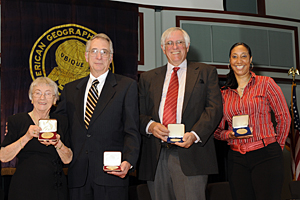
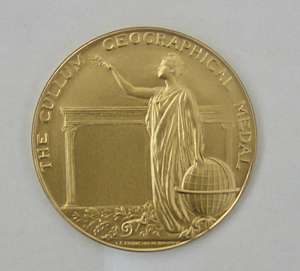
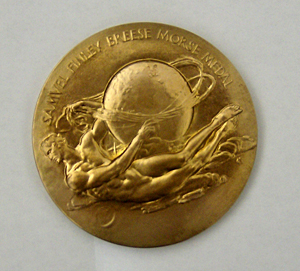
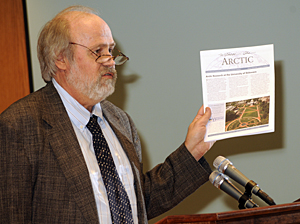
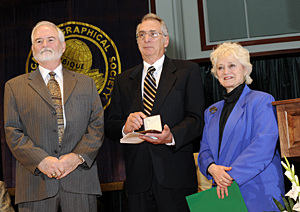
- Rozovsky wins prestigious NSF Early Career Award
- UD students meet alumni, experience 'closing bell' at NYSE
- Newark Police seek assistance in identifying suspects in robbery
- Rivlin says bipartisan budget action, stronger budget rules key to reversing debt
- Stink bugs shouldn't pose problem until late summer
- Gao to honor Placido Domingo in Washington performance
- Adopt-A-Highway project keeps Lewes road clean
- WVUD's Radiothon fundraiser runs April 1-10
- W.D. Snodgrass Symposium to honor Pulitzer winner
- New guide helps cancer patients manage symptoms
- UD in the News, March 25, 2011
- For the Record, March 25, 2011
- Public opinion expert discusses world views of U.S. in Global Agenda series
- Congressional delegation, dean laud Center for Community Research and Service program
- Center for Political Communication sets symposium on politics, entertainment
- Students work to raise funds, awareness of domestic violence
- Equestrian team wins regional championship in Western riding
- Markell, Harker stress importance of agriculture to Delaware's economy
- Carol A. Ammon MBA Case Competition winners announced
- Prof presents blood-clotting studies at Gordon Research Conference
- Sexual Assault Awareness Month events, programs announced
- Stay connected with Sea Grant, CEOE e-newsletter
- A message to UD regarding the tragedy in Japan
- More News >>
- March 31-May 14: REP stages Neil Simon's 'The Good Doctor'
- April 2: Newark plans annual 'wine and dine'
- April 5: Expert perspective on U.S. health care
- April 5: Comedian Ace Guillen to visit Scrounge
- April 6, May 4: School of Nursing sponsors research lecture series
- April 6-May 4: Confucius Institute presents Chinese Film Series on Wednesdays
- April 6: IPCC's Pachauri to discuss sustainable development in DENIN Dialogue Series
- April 7: 'WVUDstock' radiothon concert announced
- April 8: English Language Institute presents 'Arts in Translation'
- April 9: Green and Healthy Living Expo planned at The Bob
- April 9: Center for Political Communication to host Onion editor
- April 10: Alumni Easter Egg-stravaganza planned
- April 11: CDS session to focus on visual assistive technologies
- April 12: T.J. Stiles to speak at UDLA annual dinner
- April 15, 16: Annual UD push lawnmower tune-up scheduled
- April 15, 16: Master Players series presents iMusic 4, China Magpie
- April 15, 16: Delaware Symphony, UD chorus to perform Mahler work
- April 18: Former NFL Coach Bill Cowher featured in UD Speaks
- April 21-24: Sesame Street Live brings Elmo and friends to The Bob
- April 30: Save the date for Ag Day 2011 at UD
- April 30: Symposium to consider 'Frontiers at the Chemistry-Biology Interface'
- April 30-May 1: Relay for Life set at Delaware Field House
- May 4: Delaware Membrane Protein Symposium announced
- May 5: Northwestern University's Leon Keer to deliver Kerr lecture
- May 7: Women's volleyball team to host second annual Spring Fling
- Through May 3: SPPA announces speakers for 10th annual lecture series
- Through May 4: Global Agenda sees U.S. through others' eyes; World Bank president to speak
- Through May 4: 'Research on Race, Ethnicity, Culture' topic of series
- Through May 9: Black American Studies announces lecture series
- Through May 11: 'Challenges in Jewish Culture' lecture series announced
- Through May 11: Area Studies research featured in speaker series
- Through June 5: 'Andy Warhol: Behind the Camera' on view in Old College Gallery
- Through July 15: 'Bodyscapes' on view at Mechanical Hall Gallery
- More What's Happening >>
- UD calendar >>
- Middle States evaluation team on campus April 5
- Phipps named HR Liaison of the Quarter
- Senior wins iPad for participating in assessment study
- April 19: Procurement Services schedules information sessions
- UD Bookstore announces spring break hours
- HealthyU Wellness Program encourages employees to 'Step into Spring'
- April 8-29: Faculty roundtable series considers student engagement
- GRE is changing; learn more at April 15 info session
- April 30: UD Evening with Blue Rocks set for employees
- Morris Library to be open 24/7 during final exams
- More Campus FYI >>
3:21 p.m., April 20, 2009----Arctic explorers of Earth -- and Mars -- were presented national medals on April 15 at the University of Delaware during the awards ceremony of the American Geographical Society (AGS), the oldest nationwide geographical organization in the United States, founded in 1851.
Researchers who played a significant role in saving the society's library, one of the largest geographical collections in the world, also were recognized.
The Cullum Geographical Medal
AGS's oldest medal, the Cullum Geographical Medal, for those who distinguish themselves by geographical discoveries or in the advancement of geographical science, was established in 1896 through a bequest by U.S. Army Major General George W. Cullum. It has been presented to 68 luminaries over the years, including Robert Peary, its first recipient, Sir Ernest Shackleton, Rachel Carson, Neil Armstrong, and others.
The 2009 recipients include Peter Smith, principal investigator of NASA's Phoenix Mars Mission, and the late Matthew Henson, the African American explorer who accompanied Commander Robert E. Peary on the 1909 expedition to the North Pole.
Henson was indispensable to Peary, according to Mary Lynne Bird, AGS executive director. A trusted aide, skillful navigator and dog sledge driver, popular among the native Inuit people for his kindness, Henson was given the privilege of planting the U.S. flag at the northernmost point on April 6, 1909.
“Born into humble circumstances just after the Civil War, he rose above the racial barriers imposed by society ultimately to be feted by American presidents, honored by learned societies, and put to rest in his nation's most sacred burial ground,” Bird said of Henson, reading from the official citation.
Henson's great-great-great-grand niece, Leila Savoy Andrade, accepted the posthumous award under the same banner that was used when Henson signed the AGS Fliers' and Explorers' Globe in New York City on Nov. 8, 1951.
Dierdre Stam, who wrote the introduction to the Explorers Club's 2009 re-issue of Henson's 1912 autobiography, An American Negro at the North Pole, noted that two omissions of the age -- the lack of focus on the team, and racism -- resulted in public attention that was proportionate to Henson's role in 1909. Henson was an essential assistant to Peary, but relegated to the role of servant.
“Today, he [Henson] receives full, honored recognition as part of the team,” Stam noted.
AGS President Jerome Dobson introduced Peter Smith, University of Arizona professor and principal investigator of NASA's Phoenix Mars Mission, as “one who helps explore a distant planet and gives us front-row seats.”
The Phoenix Mars Lander, the first in NASA's Scout class, was launched Aug. 4, 2007, and touched down in the Martian arctic on May 25, 2008, to search the soil for the building blocks of life. Among its discoveries, the probe confirmed the presence of frozen water just below the planet's surface and discovered nutrient sources critical to microbes.
Although the lander did not find life on the Red Planet, the mission is an important steppingstone to new adventures, Smith said.
“No one was home when we went to take a look,” he noted. “I'm making a prediction that we will find life outside the Earth within 10 years.”
The Samuel F. B. Morse Medal
Barbara Borowiecki, professor emerita of geography, and William Roselle, retired director of the Golda Meir Library, both from the University of Wisconsin-Milwaukee (UMW), received the Samuel Finley Breese Morse Medal for their “drive, dedication, and spirit” in moving the American Geographical Society's library from New York City to that university in the 1970s.
Established in 1902 “for the encouragement of geographical research,” the Morse medal has been awarded to only 14 individuals.
The AGS sought a new home for the library in the 1970s because it lacked the facilities and staff to maintain the collection, at that time over 600,000 items, including maps, globes, atlases, books, photographs, and other materials.
Borowiecki and Roselle vied to have the collection moved to UMW. The transfer, which initially was contested by a number of parties ranging from the New York Public Library to then mayor of New York City Ed Koch, required complex negotiations.
Reading from the official citation, AGS's Bird referred to Borowiecki, a noted geomorphologist, as “the sparkplug of the campaign.”
As a young woman, Borowiecki worked for the Polish resistance. After her family immigrated to the United States, she learned English and earned her bachelor's, master's, and doctoral degrees in six years.
Among her goals, she said, was to achieve “something really special to thank the U.S.A. for having me here as a citizen.”
When the opportunity arose to provide a new home for the AGS Collection, Borowiecki said, “I put my foot down and said 'go ahead and do it.' ”
In his official citation, William Roselle was referred to as “hunter and gatherer, preserver of the past and champion of the future, discoverer and innovator.”
Bird noted that under Roselle's tenure, the library was “safely transferred, carefully transplanted, and expertly tended” and the holdings have more than doubled.
Roselle spoke of the transfer of the collection, which required 16 moving vans and state police escorts from New York to Wisconsin.
He thanked the faculty and staffs of the Golda Meir Library for their dedication to the effort.
“Without them, this would never have come to pass,” Roselle said.
The ceremony and awardee lectures on April 16-17 concluded the University's William S. Carlson International Polar Year Events, a series of public lectures, seminars, receptions, exhibitions, and films that commenced in February 2008 to celebrate UD's president from 1946-1950 who was an Arctic explorer, and the University's significant polar research in the world's fourth International Polar Year, which concluded in April 2009.
The series was co-sponsored by the American Geographical Society and by the UD Office of the Provost, Center for International Studies, Research Office, Office of Graduate and Professional Education, Office of Communications & Marketing, the UD Libraries, University Museums, the Academy of Lifelong Learning, and UD's seven colleges -- Agriculture and Natural Resources; Arts and Sciences; Lerner College of Business and Economics; Engineering; Health Sciences; Human Services, Education and Public Policy; and Marine and Earth Studies.
The steering committee for the series was co-chaired by Frederick “Fritz” Nelson, professor of geography, and Lesa Griffiths, associate provost for international programs.
Article by Tracey Bryant
Photos by Duane Perry


